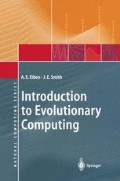Abstract
Evolutionary computing is a research area within computer science. As the name suggests, it is a special flavour of computing, which draws inspiration from the process of natural evolution- That some computer scientists have chosen natural evolution as a source of inspiration is not surprising, for the power of evolution in nature is evident in the diverse species that make up our world, with each tailored to survive well in its own niche. The fundamental metaphor of evolutionary computing relates this powerful natural evolution to a particular style of problem solving — that of trial-and-error.
Access this chapter
Tax calculation will be finalised at checkout
Purchases are for personal use only
Preview
Unable to display preview. Download preview PDF.
References
Charles Darwin. The Origin of Species. John Murray, 1859. The world-famous book introducing the theory of evolution, based on Darwin’s observations from his trip in the Beagle.
R. Dawkins. The Selfish Gene. Oxford University Press, 1976. A “pop-science” classic, promoting “neo-Darwinism” as a synthesis of evolution with modern genetics. Its very “gene-centric” view of evolution, has been questioned by some.
J. Maynard-Smith. The Evolution of Sex. Cambridge University Press, 1978. A good, readable introduction to the biological basics of reproduction in haploid and diploid organisms.
S. Wright. The roles of mutation, inbreeding, cross-breeding, and selection in evolution. In: Proc. of 6th Int. Congr. on Genetics, vol. 1, pp. 356–366. Ithaca, NY, 1932. The paper introducing the idea of the adaptive landscapes.
D.B. Fogel, ed. Evolutionary Computation: the Fossil Record. IEEE Press, 1998. Fascinating collection of early works in the field, interesting not just for historical insight.
S.A. Kauffman. Origins of Order: Self-Organization and Selection in Evolution. Oxford University Press, New York, 1993. Offers a different perspective on the processes that lead to the origins of life.
Author information
Authors and Affiliations
Rights and permissions
Copyright information
© 2003 Springer-Verlag Berlin Heidelberg
About this chapter
Cite this chapter
Eiben, A.E., Smith, J.E. (2003). Introduction. In: Introduction to Evolutionary Computing. Natural Computing Series. Springer, Berlin, Heidelberg. https://doi.org/10.1007/978-3-662-05094-1_1
Download citation
DOI: https://doi.org/10.1007/978-3-662-05094-1_1
Publisher Name: Springer, Berlin, Heidelberg
Print ISBN: 978-3-642-07285-7
Online ISBN: 978-3-662-05094-1
eBook Packages: Springer Book Archive

